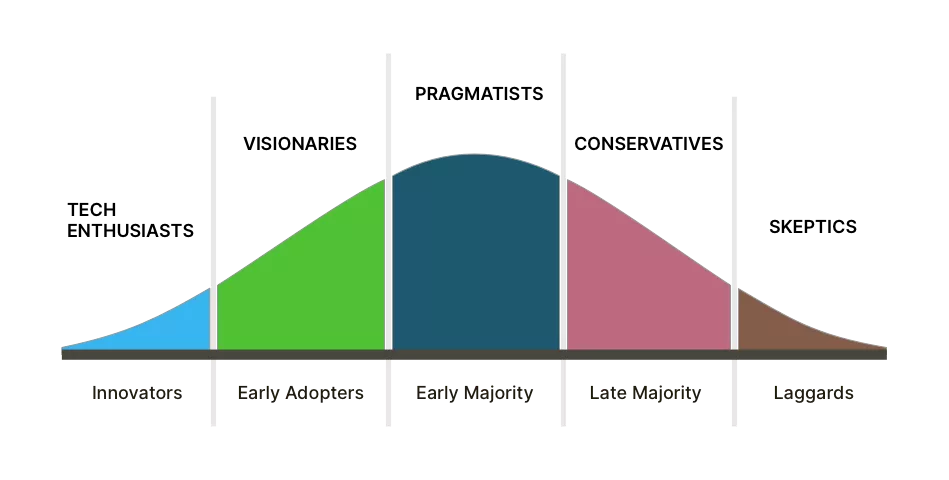The market diffusion process describes how an innovation progresses through a market – that is, how it reaches various segments and buyer types that are present in the specific market. In addition, it provides information that enables management to identify target markets. For these reasons, it is crucial to understand the facets of the market diffusion process and its importance for the new product development process (NPD). In the following, we will explore the market diffusion process in more detail and derive marketing implications.
The market diffusion process is strongly linked to the adoption process. It describes how an individual customer learns about an innovation. During the market diffusion process, the marketer must recognize that people differ greatly in their readiness to adopt new products. By the time consumers take to adopt new products, we can distinguish five market segments. Let’s have a closer look at these five segments.

Innovators are the “early-bird” customers, that is, the first ones to adopt the new product. They do normally not represent more than 2.5% of the population. They are venturesome and prepared to run the risk of buying a product that ultimately proves not to live up to their expectations, rather than missing the chance to try something new. For the marketer, innovators are important since they represent the initial target and influence later adopters. A new product that fails to win the esteem of this group is not very likely to ever reach and penetrate the mass market.
Early adopters represent the next 13.5% of the population to adopt the new product. As respected members of the community, they are the opinion leaders for those who will only buy the product “approved” by the early adopters.
The early majority accounts for about 34% of the population. This type of customer is more cautious of new products than the early adopters. If they have sufficient information they will follow the example of the early adopters. The early majority is an important target for firms who aim to take their products from the introduction to the growth stage of the PLC.
The late majority are the 34% of the population who are more skeptical about new products and harder to persuade. They place greater importance on word-of-mouth recommendations than the media to obtain information about new products.
Laggards are the last 16% of the population. They are the most reluctant to try new products. Often, they adopt new products only when their favored items have been discontinued. Members of this group are often older and/or from lower socio-economic groups.
The five types of customers can be placed on the product life cycle curve as illustrated below.

The market diffusion process, also called the diffusion of innovation, is closely related to the PLC. You can use it both for segmenting a market and for suggesting appropriate marketing activities. Promoting to the ‘average’ consumer will be ineffective unless the innovators and early adopters have experienced the product and are willing to recommend it. The marketing mix will need to change radically as the product moves through the segments of the market diffusion process. For example, innovators do normally use different distribution channels and read different media from later adopters. As a result, a manufacturer of a new hi-fi product may decide to reach the innovators and early adopters through specialist magazines and hi-fi centers in the premium-priced sector of the market. To attract the late majority and the laggards, however, different media and retail outlets will have to be used to promote the product. Learn about the implications of the market diffusion process from the table below.
| Approach | Advantages | Disadvantages |
|---|---|---|
| Brand managers | Close to the market | Preoccupation with existing brands, a short-term perspective, lack of specialist NPD skills |
| New product managers | Provide a strong focus for NPD, add professionalism | Strong guidelines are required, sometimes fail to communicate with other departments |
| New product committees | Add credibility to the process, as members are often senior employees | Bureaucratic, can overlook detail, often slow and cumbersome, prone to political conflict, sometimes concentrates on pet projects and ignores others |
| New product departments | Strong focus, suited to large organizations with large portfolios | Strong guidelines are required, and sometimes fail to communicate with other departments |
| Venture teams | Encourage entrepreneurial development | Expensive if the results are not significant; staff can experience problems when returning to original posts |
Having a clear idea of the market diffusion process is key to success for every company. Without this knowledge, it is impossible to properly forecast the sales volume and development of sales over the early stages of a product or service.

Email subscription is available ONLY TODAY (oh, okay, and tomorrow).
Surely, we respect your inbox! Unsubscription works every day.

We’d love to tailor your experience — which of these best describes you?